| Author |
Message |
Thomas McDonald
myArmoury Alumni


|
 Posted: Sat 03 Sep, 2005 11:22 am Post subject: Posted: Sat 03 Sep, 2005 11:22 am Post subject: |
 |
|
L 1957-11, Claymore, c. 1590 .

Photo: Thirteenth Park Lane Arms Fair, 1996.
* This piece, L 1957-11, is also pictured in John Wallace's book, 'Scottish Swords & Dirks', and on my PictureTrail site in the album 'Claymore's at the Museum of Scotland' .
Mac
'Gott Bewahr Die Oprechte Schotten'
XX ANDRIA XX FARARA XX
Mac's PictureTrail
Last edited by Thomas McDonald on Thu 08 Sep, 2005 5:44 pm; edited 1 time in total
|
|
   |
 |
Thomas McDonald
myArmoury Alumni


|
 Posted: Sat 03 Sep, 2005 12:20 pm Post subject: Posted: Sat 03 Sep, 2005 12:20 pm Post subject: |
 |
|
Claymore, Sir John Lundin's
"The swords of the Scottish heroes who fought at the Battles of Stirling Bridge(1297) and Bannockburn(1314)
- Sir William Wallace, King Robert Bruce, Sir John de Graham, Sir Richard Lundin, and Sir James Douglas.
These were exhibited at the laying of the foundation stone of the Wallace Monument in 1861, and all of them still survive." -- Introducing William Wallace; The Life and Legacy of Scotland's Liberator, by Elspeth King
Mac
 Attachment: 85.57 KB Attachment: 85.57 KB
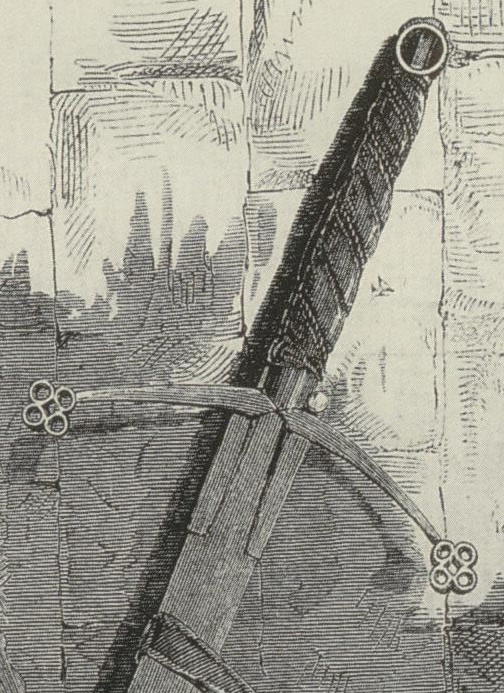
 Attachment: 104.41 KB Attachment: 104.41 KB
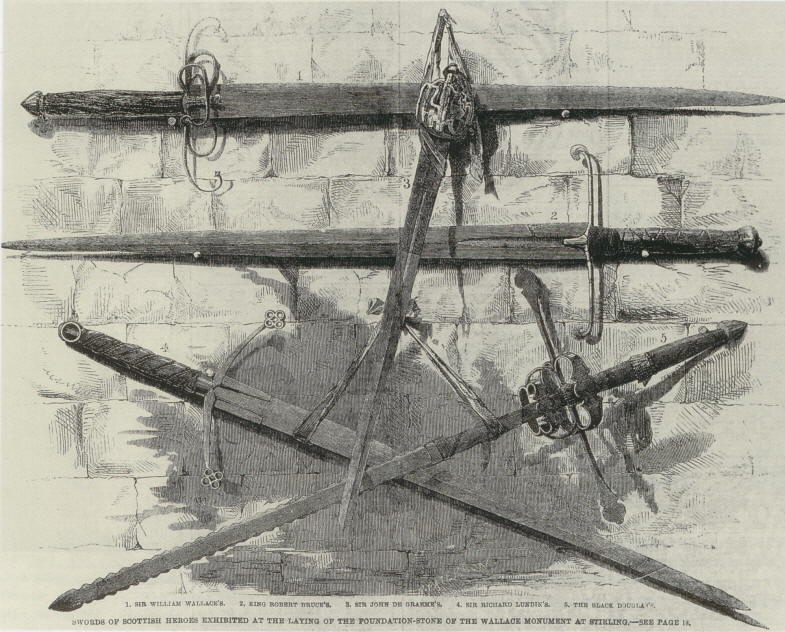
'Gott Bewahr Die Oprechte Schotten'
XX ANDRIA XX FARARA XX
Mac's PictureTrail
|
|
   |
 |
|
Russ Ellis
Industry Professional
|
 Posted: Sat 03 Sep, 2005 12:43 pm Post subject: Posted: Sat 03 Sep, 2005 12:43 pm Post subject: |
 |
|
| Lee O'Hagan wrote: | 
If you ever need to rehome any of those closer to the homeland mac,i could maybe help you out,  
as of this morning fuel here is now 96pence a litre for unleaded and 99pence for diesel, 
Like the new sword russ,i was thinking of one of these as they were listed,looks pretty  |
Thanks Lee!
Mac has shown us such a plethora of giant highland beauties I'm just glad they let me be a probationary member of the club... 
TRITONWORKS Custom Scabbards
|
|
  |
 |
|
Ruel A. Macaraeg
|
 Posted: Sat 03 Sep, 2005 12:49 pm Post subject: Posted: Sat 03 Sep, 2005 12:49 pm Post subject: |
 |
|
|
Would anyone care to speculate as to why Scottish claymores seem always to have had grips of circular cross section -- ie., why they lack edge alignment? I've wondered about this for some time now.
|
|
    |
 |
Thomas McDonald
myArmoury Alumni


|
 Posted: Sat 03 Sep, 2005 1:25 pm Post subject: Posted: Sat 03 Sep, 2005 1:25 pm Post subject: |
 |
|
Hi Ruel
Interesting question .... and I don't have any definitive answer for you, but .... my 2 cents !
Alot of the handles that appear very round in section sometimes do have subtle changes along the length, whether it be thickness, faceted, or slight ovaling in areas !
Personally, I've never had a problem keeping the edge aligned when cutting with a handle that is round in section, especially when gripped with two hands !
Anyone else care to speculate? Mac
 Attachment: 64.43 KB Attachment: 64.43 KB
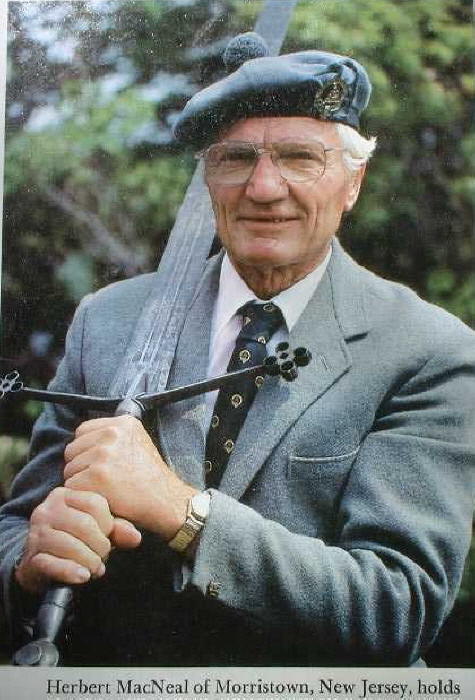
'Gott Bewahr Die Oprechte Schotten'
XX ANDRIA XX FARARA XX
Mac's PictureTrail
|
|
   |
 |
Thomas McDonald
myArmoury Alumni


|
 Posted: Sat 03 Sep, 2005 2:58 pm Post subject: Posted: Sat 03 Sep, 2005 2:58 pm Post subject: |
 |
|
Mac
 Attachment: 32.99 KB Attachment: 32.99 KB
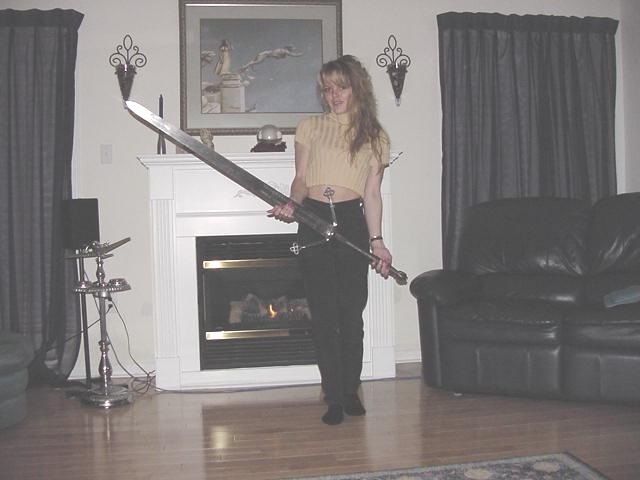
'Gott Bewahr Die Oprechte Schotten'
XX ANDRIA XX FARARA XX
Mac's PictureTrail
|
|
   |
 |
Thomas McDonald
myArmoury Alumni


|
 Posted: Sat 03 Sep, 2005 3:48 pm Post subject: Posted: Sat 03 Sep, 2005 3:48 pm Post subject: |
 |
|
1. Claymore - residing at The Culloden Visitors Center, near Inverness !

2. A claymore that was sold via Wallis & Wallis auction house !
3. Claymore at Edinburgh Castle !
Mac
 Attachment: 81.83 KB Attachment: 81.83 KB
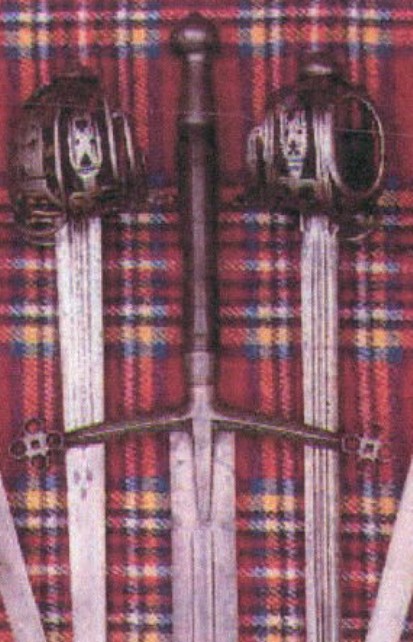
 Attachment: 60.14 KB Attachment: 60.14 KB
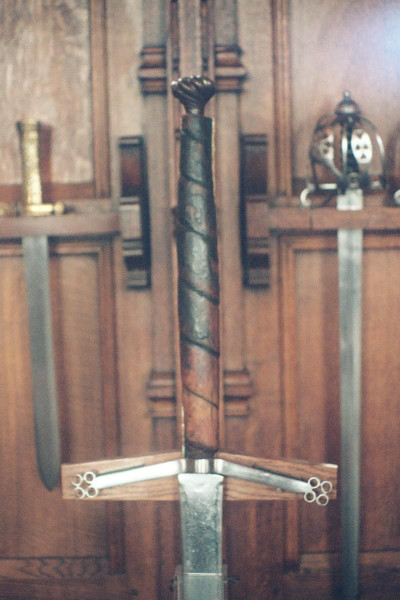
'Gott Bewahr Die Oprechte Schotten'
XX ANDRIA XX FARARA XX
Mac's PictureTrail
|
|
   |
 |
|
Mark Moore
|
 Posted: Sat 03 Sep, 2005 6:14 pm Post subject: Posted: Sat 03 Sep, 2005 6:14 pm Post subject: |
 |
|
Speechless..........sitting...............drooling..........Wow. Fantastic pics, Mac. I would love to get on the comission bandwagon and have a 4-quillon claymore built.......but alas, the only wagon I'm riding at the moment is the one going to the poorhouse. I reckon I'll save my pennies and see what Albion and ATrim come out with in the future. I have a gut feeling that Albion will be showing us some big Scotties in the future. Hint...hint...hint..., Howy.  Bring on the claymores! Pics of members swords!!! ............mcm. Bring on the claymores! Pics of members swords!!! ............mcm.
|
|
  |
 |
Thomas McDonald
myArmoury Alumni


|
 Posted: Sun 04 Sep, 2005 5:49 am Post subject: Posted: Sun 04 Sep, 2005 5:49 am Post subject: |
 |
|
1. Claymore at the Tower of London, 16th century. IX-912
Photo: European Swords & Daggers in the Tower of London, A.R. Dufty, 1974.
2. Claidheamh dà làimh at the Kelvingrove Museum, Glasgow. No: E.1939.65.ht.
Photo copyright: Glasgow Museums/Kelvingrove
Mac
 Attachment: 64.5 KB Attachment: 64.5 KB
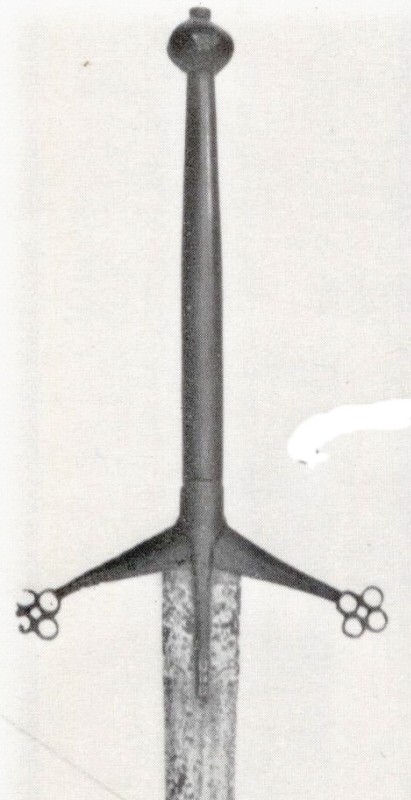
 Attachment: 21.35 KB Attachment: 21.35 KB
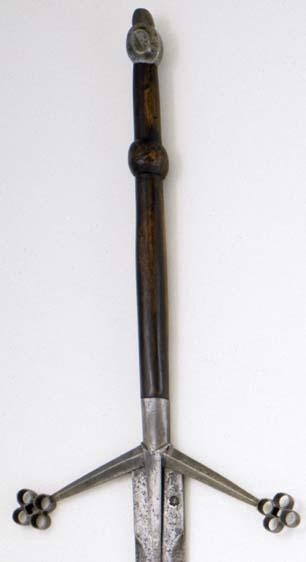
'Gott Bewahr Die Oprechte Schotten'
XX ANDRIA XX FARARA XX
Mac's PictureTrail
|
|
   |
 |
Thomas McDonald
myArmoury Alumni


|
 Posted: Sun 04 Sep, 2005 7:37 am Post subject: Posted: Sun 04 Sep, 2005 7:37 am Post subject: |
 |
|
Mac
 Attachment: 45.38 KB Attachment: 45.38 KB

 Attachment: 64.81 KB Attachment: 64.81 KB

'Gott Bewahr Die Oprechte Schotten'
XX ANDRIA XX FARARA XX
Mac's PictureTrail
|
|
   |
 |
Thomas McDonald
myArmoury Alumni


|
 Posted: Sun 04 Sep, 2005 7:42 am Post subject: Posted: Sun 04 Sep, 2005 7:42 am Post subject: |
 |
|
1. Wallis & Wallis auction house.
2. Kris Cutlery claymore
Photo: Adian Ko, SFI.
3. Claidheamh dà làimh, James Drummond 'Ancient Scottish Weapons', 1881.
 Attachment: 67.23 KB Attachment: 67.23 KB
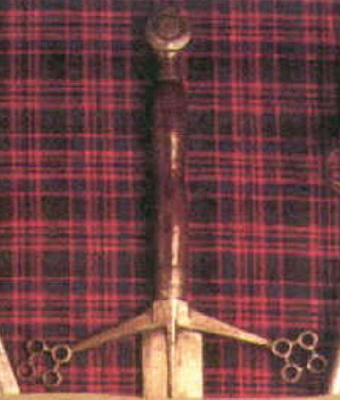
 Attachment: 60.58 KB Attachment: 60.58 KB
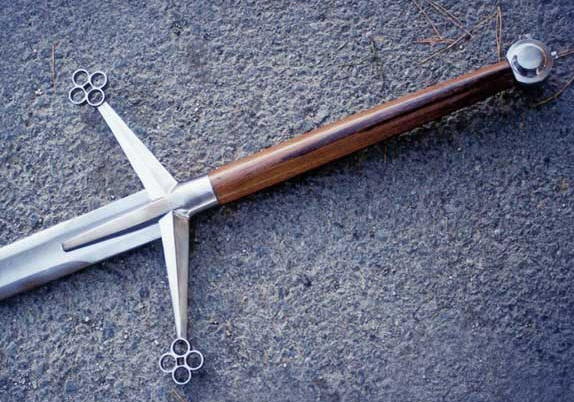
 Attachment: 44.62 KB Attachment: 44.62 KB
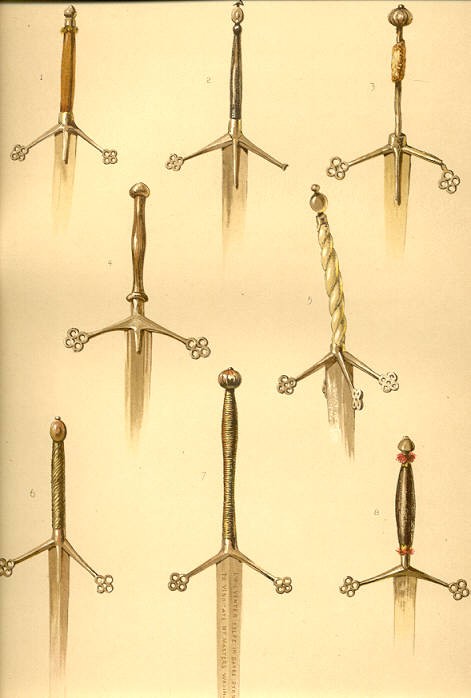
'Gott Bewahr Die Oprechte Schotten'
XX ANDRIA XX FARARA XX
Mac's PictureTrail
|
|
   |
 |
Jared Smith

|
 Posted: Sun 04 Sep, 2005 8:34 am Post subject: purpose of "langets"? Posted: Sun 04 Sep, 2005 8:34 am Post subject: purpose of "langets"? |
 |
|
I don't know the actual purpose of the "langets" either. I would believe a historical account if it stated that it was purely ornamental. Some very wild guesses at possible functional purposes are offered below.
With some reproductions the full width of both gaps can open all on one side during blade against blade binding, enough to trap an opponent's edge. This would not be a tactic that I would want to perform deliberately, but if occured I would consider it preferrable to having my hands sliced. I have no idea if this characteristic is is true of any historical swords.
The antique examples I can find pictures of (on the internet) seem to have either a sharp taper or gradual taper where the "langets" end at the blade. This could be beneficial for deflecting (causing it to skip and be less likely to sweep into hands) an opponent's blade after binding and winding. Just a guess.
Absence of evidence is not necessarily evidence of absence!
|
|
  |
 |
Thomas McDonald
myArmoury Alumni


|
 Posted: Sun 04 Sep, 2005 10:08 am Post subject: Posted: Sun 04 Sep, 2005 10:08 am Post subject: |
 |
|
Side-tracking a tad ....
While trying to findout some more information on the Noel Paton claymore (which I posted a pic of earlier in this thread) I came across the Hunterian Museums website and found some interesting things there ! While not exactly the info I was seeking, it did give me a good idea who Sir Joseph Noel Paton was, and some cool stuff on King Robert the Bruce !
The following is taken from their site !
(the painting by Stirling Smith was scanned from "Introducing William Wallace" by Elspeth King .) Slàinte, Mac
Sunday 23rd June 1314, Sir Henry de Bohun recognises the lone horseman marshalling the Scots as none other than the king himself, Robert the Bruce. Acting on impulse, the inexperienced young knight forces his horse into a gallop, lowers his lance and charges. The warriors collide in front of their respective forces and the combat is quickly drawn to a close, Robert the Bruce returns to his men, de Bohun doesn't. The English knight's cause of death was a devastating blow to the head which not only split his helmet and skull, but was carried out with such force, that the haft of the battle-axe used to kill him was broken in the process.

We would like to thank Perth Museum & Art Gallery, Perth & Kinross Council, for the loan of the axe
http://www.hunterian.gla.ac.uk/Archives/robert/bannockburn.shtml

*"Introducing William Wallace" by Elspeth King
http://www.hunterian.gla.ac.uk/Archives/rober...lics.shtml
Provenance of The Relics
On 17th February 1818, whilst constructing a new church adjacent to the old one at Dunfermline Abbey, some workmen accidentally exposed a vault in which a tomb was discovered. The vault was immediately covered up with large stones until an official investigation could be carried out. On the 5th November 1819 at 11.00 am the investigation began, and was recorded by The King's Remembrancer, Sir Henry Jardine. Dr. Gregory, His Majesty's first physician for Scotland, Dr Munro, the Professor of Anatomy at the University of Edinburgh, and other gentlemen of science including Joseph Neil Paton were in attendance. The examination of the tomb revealed that this was the final resting place of Robert the Bruce.
A fellow of the Scottish Society of Antiquaries, Joseph Neil Paton managed to acquire a metatarsal bone (from the foot), a small piece of the gold coloured shroud, a coffin handle and a nail fragment from the coffin, seen here. Like many wealthy men of that time, he was an avid antiquarian and assembled a collection of 'articles of curiosity'. His small museum was sold at auction in Edinburgh after his death, but the Bruce relics remained in the family.

Plaster cast taken from skull of Robert the Bruce, artefact cast , Materials: Plaster, Locality: Dunfermline SCOTLAND
Manufacture: MANU Robert I 1306-1329 Dunfermline Abbey Scotland
The relics were passed down to his son, Sir Joseph Noel Paton (1821-1901), who, like his father, was a man of status in Dunfermline, and Scotland. As his father had done before him, the famous painter and poet passed the relics on once more to his son, Diarmid Noel Paton (1859-1928). Diarmid Paton was an Edinburgh graduate who came to Glasgow to be Professor in Physiology from 1907; upon his death in 1928 the relics were bequeathed to the Hunterian Museum.
Skeleton of Robert the Bruce

Further Information On The Paton Family
Joseph Neil Paton's wife Catherine McDiarmid, claimed to be a direct descendent of Robert the Bruce and Malcolm Canmore (King Malcolm III of Scotland 1058-1093) who was also buried at Dunfermline abbey. As well as being an avid antiquarian, Joseph Neil Paton was a damask manufacturer in Dunfermline. At that time Dunfermline was renowned as a handloom weaving town that produced damask linen and later silks.
Joseph Noel Paton (1821-1901) studied at the Royal Academy in London, and became a painter of historical, fairy, allegorical and religious subjects. He was appointed Queen's Limner for Scotland in 1865 and produced two volumes of poetry, 'Poems by a Painter', and 'Spindrift'. He was knighted in 1866 and in 1888 became a Freeman of the Royal Burgh of Dunfermline. He also designed a stained glass window for the nave of Dunfermline Abbey. Queen Victoria commissioned, and purchased several of his paintings.

Second right metatarsal bone from foot of Robert the Bruce, artefact bone, Materials: Bone, Locality: Dunfermline SCOTLAND, Manufacture: MANU Robert I 1306-1329 Dunfermline Abbey Scotland.
At the turn of the century, Diarmid Noel Paton (1859-1928) became the first Superintendent of the Research Laboratories at the Royal College of Physicians of Edinburgh. He became Regius Professor of Physiology at Glasgow in 1907, and is considered by many to be the first Scottish Biochemist. He died on 30th of September 1928, the day he retired from his Chair. The Bruce relics passed down from his grandfather were bequeathed to the Hunterian Museum.
This information is © The Hunterian Museum and Art Gallery, University of Glasgow 2005
'Gott Bewahr Die Oprechte Schotten'
XX ANDRIA XX FARARA XX
Mac's PictureTrail
|
|
   |
 |
Thomas McDonald
myArmoury Alumni


|
 Posted: Sun 04 Sep, 2005 1:31 pm Post subject: Posted: Sun 04 Sep, 2005 1:31 pm Post subject: |
 |
|
An older reproduction claymore in the collection of Eoin Cummings !
Mac
 Attachment: 60.67 KB Attachment: 60.67 KB
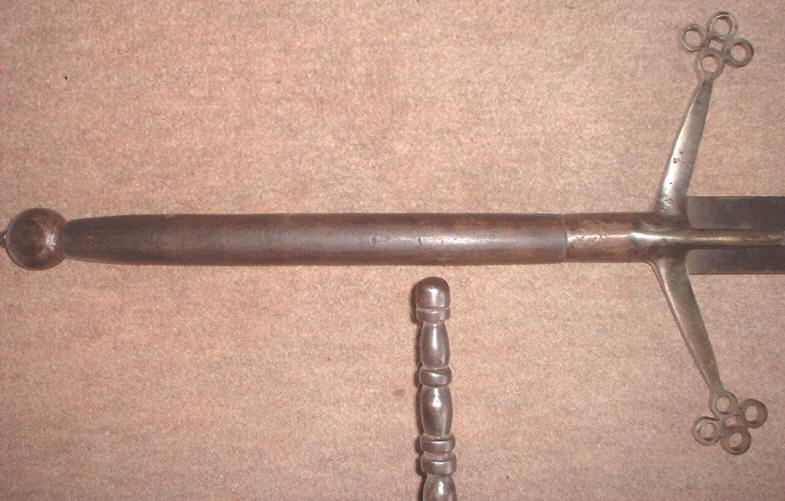
'Gott Bewahr Die Oprechte Schotten'
XX ANDRIA XX FARARA XX
Mac's PictureTrail
|
|
   |
 |
Thomas McDonald
myArmoury Alumni


|
 Posted: Sun 04 Sep, 2005 2:48 pm Post subject: Posted: Sun 04 Sep, 2005 2:48 pm Post subject: |
 |
|
Gary Stewart wrote :
"Here we have a surprisingly light Highland two handed sword (claidheamh da laimh) probably 16th century , O 55" ,B 41.5" , Blade width 1.75". Kelvingrove Museum Weapons Trip
Mac
 Attachment: 27.01 KB Attachment: 27.01 KB
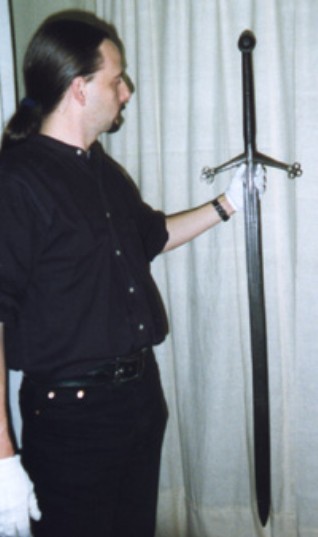
'Gott Bewahr Die Oprechte Schotten'
XX ANDRIA XX FARARA XX
Mac's PictureTrail
|
|
   |
 |
Steve Grisetti

|
 Posted: Sun 04 Sep, 2005 5:46 pm Post subject: Posted: Sun 04 Sep, 2005 5:46 pm Post subject: |
 |
|
| Thomas McDonald wrote: | Side-tracking a tad ....
... The examination of the tomb revealed that this was the final resting place of Robert the Bruce...

Plaster cast taken from skull of Robert the Bruce, artefact cast , Materials: Plaster, Locality: Dunfermline SCOTLAND
Manufacture: MANU Robert I 1306-1329 Dunfermline Abbey Scotland |
Side-tracking just a little bit more...when I saw the cast of the Bruce's skull (above), I was thinking, "hey, from that, we can get an idea of what the guy actually looked like." Sure enough, on the last page of the Hunterian website, I found the recreation, shown below. Cool.
 Attachment: 12.56 KB Attachment: 12.56 KB
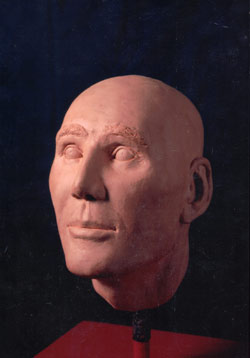
Model Recreation - Head of Robert the Bruce (from Hunterian website)
|
|
  |
 |
|
Patrick Fitzmartin
|
 Posted: Sun 04 Sep, 2005 6:32 pm Post subject: Hey Mac! Posted: Sun 04 Sep, 2005 6:32 pm Post subject: Hey Mac! |
 |
|
Greetings Russ Ellis and Mac, We go again "sidelining" this wonderful thread. It's partially your fault Russ. The Scottish "Claymore" is such an interesting sword type. Then you add an avid type of guy like Mac and here we go. Russ, you now own one of the finest models available on the market today. I know. I used to own one.  Mac, you have my profound thanks for all the examples you have posted on this thread showing the great variety that exsists in this one sword "niche". It is really great to see this in this day and age of "pigeon holeing". I am going to build my own due to personal and " economic" reasons but you have given me enough examples to come up with something plausible enough. It would be great to see this in the other sword "niches" because while we have historical examples that does not mean we have "everything" that exsisted. Again Mac, I compliment you and salute your efforts because I have seen you come up with some real "whoppers" in several catagories. Mac, you have my profound thanks for all the examples you have posted on this thread showing the great variety that exsists in this one sword "niche". It is really great to see this in this day and age of "pigeon holeing". I am going to build my own due to personal and " economic" reasons but you have given me enough examples to come up with something plausible enough. It would be great to see this in the other sword "niches" because while we have historical examples that does not mean we have "everything" that exsisted. Again Mac, I compliment you and salute your efforts because I have seen you come up with some real "whoppers" in several catagories.  Sincerely, Patrick Fitzmartin Sincerely, Patrick Fitzmartin
|
|
  |
 |
|
Russ Ellis
Industry Professional
|
 Posted: Sun 04 Sep, 2005 9:36 pm Post subject: Posted: Sun 04 Sep, 2005 9:36 pm Post subject: |
 |
|
I'm so glad this thread went the way it has! Mac I'm thoroughly enjoying all the fantastic pictures. Is it just my imagination or do you like claymores a little? 
TRITONWORKS Custom Scabbards
|
|
  |
 |
|
Joe Maccarrone
Location: Burien, WA USA Joined: 19 Sep 2003
Posts: 190
|
 Posted: Mon 05 Sep, 2005 12:14 am Post subject: Posted: Mon 05 Sep, 2005 12:14 am Post subject: |
 |
|
|
Mac, based on his skeleton, did they estimate the size of Robert Bruce? His physical power and fighting ability were, of course, legendary...
|
|
  |
 |
Thomas McDonald
myArmoury Alumni


|
 Posted: Mon 05 Sep, 2005 4:36 am Post subject: Posted: Mon 05 Sep, 2005 4:36 am Post subject: |
 |
|
| Joe Maccarrone wrote: | | Mac, based on his skeleton, did they estimate the size of Robert Bruce? His physical power and fighting ability were, of course, legendary... |
Thanks, Guys :-)
Joe
I believe the skeleton was about 6 feet in length ! Mac
1818.—-DISCOVERY OF KING ROBERT THE BRUCE'S REMAINS.. —The Bruce's remains were accidentally discovery in the Choir of the Old Abbey, on February 17th, 1818. We give the following details of this interesting event from our MS. Notes :—
http://www.electricscotland.com/history/dunfe...9part5.htm
During the progress of clearing away the rubbish and levelling the area of the Psalter Churchyard (the site of the ancient Choir), preparatory to the erection of a new church on the site, the workmen, on the 17th of February, 1818, came accidentally on a vault, near the east end, where formerly the Great, or High Altar had stood. The vault was roughly put together, and of soft freestone. In length it was found to be 7 feet 6 inches, and in breadth 2 feet 4 1/2 inches. The cover consisted of two slab-stones of unequal size, and attached to them by lead fastenings were several large iron rings, which had served as handles for the purpose of lowering it. Some of these rings were in a state of utter decay and some were quick detached from the cover. On removing the cover, another vault or built space was found, composed of the same kind of stone, but a little less in its dimensions, being only 7 feet in length, and 22 1/2 inches in breadth. The outer vault was oblong and curved at the east end, the bottom of which was well paved with large slab-stones but near the middle of it there was an open space or fracture nearly 2 inches in breadth.
In this inner vault or space lay the skeleton of a large body, about six feet long, encased or wrapt up in thin sheet-lead. The lead consisted of two thin coats, each about the tenth of an inch in thickness; the upper coat of lead was much more wasted than the under coating or wrapping ; the under lead-wrapping was nearly entire, excepting at the breast, knees, and feet, where it was much decayed, exhibiting part of the skeleton in a state of high preservation ; the lead-covering had sunk a little into the abdomen, and was there much depressed. In this inner vault were found several fragments of fine linen interwoven with gold (the toile d'or, or cloth of gold, used as a shroud for the body). Fragments of wood, in a very decayed state, were found all round the skeleton, and appeared to have been the remains of the costly wooden coffin which, had encased his body; they were of oak, and attached to one or two of the pieces were large iron nails with broad heads, while one or two were found lying free, and below the skeleton. After this, the first inspection, the grave-vault was closed, and a careful watch kept over the vault by nightly detachments of the constables of the burgh.
The Barons of the Exchequer were immediately informed of the interesting discovery. In their reply, they ordered the authorities in Dunfermline to place three rows of large flat stones over the vault to protect it from depredadations or intrusive curiosity, and to get these fastened together by iron bars, till the intentions of the Barons "as to further procedure for a more thorough investigation were determined on." (See Annals of Dunf. date Nov. 5, 1819, for second investigation, ceremonies, and re-interment.)
The discovery of the remains of King Robert the Bruce at Dunfermline soon spread over the whole country, newspapers, magazines, and fly-sheets gave full notices of the immortal hero-king, and for months it was the all-absorbing talk—King Robert the Bruce, his exploits, Bannockburn, his death, and interment in 1329 , and this his discovery, after a lapse of 489 years, was the theme of conversation.
http://www.rosslyntemplars.org.uk/robert_the_bruce.htm
Matthew Kaufman
“Analysis of the skull of Robert the Bruce”
http://www.wallacebruce.stir.ac.uk/Abstracts.htm
The general consensus would appear to be that the Cast of the skull prepared by Scoular, when Bruce's body was formally exhumed in 1819, is of the highest quality, and probably provides the only remaining evidence as to whether he did or did not suffer from leprosy. Evidence from his three contemporaries indicates that he did not, nor is there contemporary evidence that suggests that he did. The only suggestion that he might have suffered from leprosy was made by an unknown monk living in Carlisle a considerable number of years after his death. The principal anatomical feature of the Cast that is consistent with facies leprosa is the appearance of his pre-maxillary region. According to Møller-Christensen, a leading authority on the skeletal features of this condition, it displays clear evidence of pre-maxillary erosion, with loss of the associated teeth - a feature of leprosy. In the absence of the inflammatory changes of the hard palate, not visible on the Cast, Møller-Christensen, however, indicated that he could not be 100% sure of the diagnosis of leprosy. He indicated that this would require unearthing the skeleton once more to examine this region of the skull. In favour of this hypothesis is the appearance of the pre-maxillary region in the engraving of the exposed skull and upper torso that Jardine published 1822 in which the lead encasing the rest of his body is seen to be still intact. This is also consistent with the appearance of this region of the skull noted in Jardine's original Report of 1821. Pearson, claimed that the features displayed are, however, more likely those of calvaria syphilitica (syphilitic osteitis). According to the contemporary account by Gregory, several of his teeth were so loose that they came out during the preparation of the Cast of his skull. This observation would appear to contrast with Jardine's description of this region of the skull, and its appearance shown in Lizars' engraving.
A considerable portion of the left zygomatic arch of the Cast is also missing. When this occurred is unclear, although the two ends of the arch appear to show evidence of healing. This feature was certainly noted by Pearson, who published a detailed account of this skull in 1924, but was not noted by Liston who provided the formal account of the skull published as Appendix I by Jardine in 1821, or by any of the other contemporary observers. It has therefore been suggested that as there appears to be no obvious signs of the considerable fracture of the jaw bone in front, as described by Jardine, the possibility exists that, he may have in error been describing the damage to the left zygomatic arch. This would also be consistent with his lack of anatomical knowledge. If the zygomatic damage is consistent with long-standing trauma to this region of the skull, as suggested by Pearson and others, then it is unclear why this feature is not shown on any of the relatively recent facial reconstructions of Bruce prepared by Richard Neave, Brian Hill and Peter Vanezis. All, however, noted the difference in size of the two orbits, possibly resulting from a fracture of the left cheekbone, and believed to be a result of a blunt injury to this region of the skull.
http://thecapitalscot.com/bruce/heart.html
http://hnn.us/roundup/entries/3982.html
'Gott Bewahr Die Oprechte Schotten'
XX ANDRIA XX FARARA XX
Mac's PictureTrail
|
|
   |
 |
|
|
You cannot post new topics in this forum
You cannot reply to topics in this forum
You cannot edit your posts in this forum
You cannot delete your posts in this forum
You cannot vote in polls in this forum
You cannot attach files in this forum
You can download files in this forum
|
All contents © Copyright 2003-2024 myArmoury.com — All rights reserved
Discussion forums powered by phpBB © The phpBB Group
Switch to the Basic Low-bandwidth Version of the forum
|

